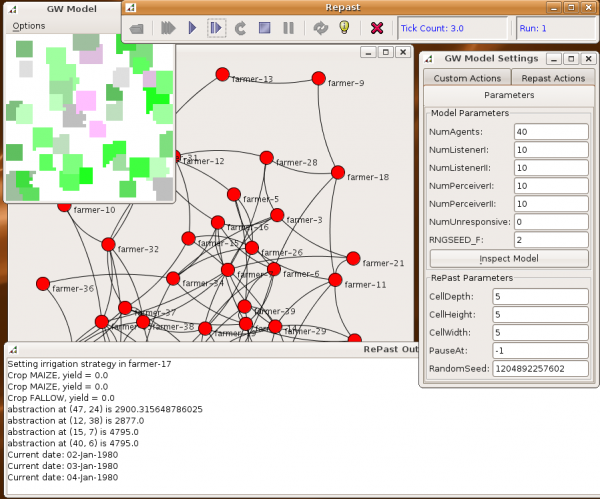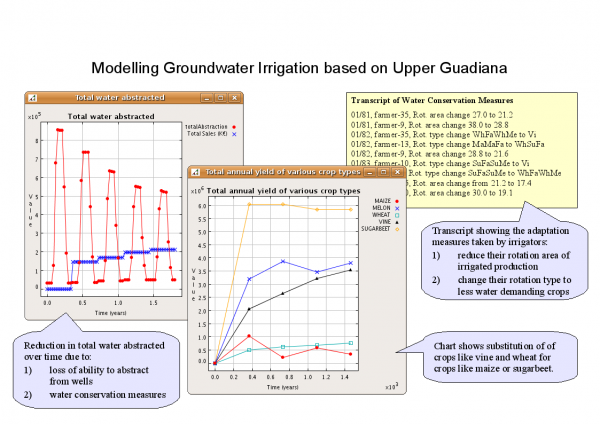Agent-based modelling

An introduction
1. An agent is an autonomous piece of program code representing an actor in a social system [1], which can be used to model many or multiple types of agency at different levels of action. The agent design templates are used to create many ‘instances’ of these actor-representations [2].
2. The rules of behaviour of agents are informed from field studies. This step involves a clarification and formalisation of knowledge about the target social system, and it also involves an abstraction step as we cannot (and nor would we want to) attempt to capture everything.
3. Having described the micro-foundational aspects, the simulation is used to explore consequences the model design by observing the aggregate (macro) outputs of the model. Batches of simulations are run as experiments to test different assumptions, different parameter choices, different initial conditions and scenarios etc.
4. ABM is a-theoretical – the assumptions and mechanisms can be flexibly defined (not depending on an apriori set of given techniques) without particular attachment to any theoretical approach. There is a school of thought that ‘a model is a theory’; without contesting this point, it is worth noting that the ABM approach lends itself to being more directly informed from observation and evidence (in contrast to the way that other areas of social theory often come to rely on ‘given’ entrenched positions that can be detached from reality). However, ABM does presuppose rich social interaction[3].
5. SEI develops ABMs in the context of environmental resources and pathways to adaptation under conditions of climate change. As well as water resources and climate aspects, these models are also equipped to incorporate geospatial features. That is, ABMs are able to read and write shapefile elements; individual agents can carry out the manipulation or such can emerge as outcomes from interaction.
6. Validation is done by testing ‘reality of assumptions’ with stakeholders. Participation is designed as an iterative process to help clarify stakeholders’ understandings, to improve the accuracy with which their knowledge is represented in the model, and to improve a model’s relevance.
A selection of introductory articles
May 2007 (Issue 2603 pgs.) New Scientist entitled: Interview: Can we model the real world? (An interview with JOSHUA M.EPSTEIN)
Simulation: an emergent perspective (by Nigel Gilbert) [1]
Projects documented on wikiADAPT in which ABMs are used
An application of ABM in the NeWater project
Agent based modelling is a way of exploring the consequences of social behaviours, and dense interactions among actors, on the natural environment. For example here we see a social network (centre panel) of irrigators situated in modelled acquifer region. 2D arial view of the farm areas (left panel) which may range in size, crop choice and water availability according to parameter choices, selection of probability distributions and initial conditions (e.g farmer types right input panel). Generally speaking the micro foundational rules are programmed (are the assumptions of the model- here we are looking at some issues affecting land use in Upper Guadiana basin) which are then explored by simulation (next figure).

Simulation shows the behaviour of the model -availablilty of groundwater is restricted due to over abstraction. The following principle is interesting for many people working in ABM: relatively simple rules can generate significant complexity in the macro outputs. Agents have the ability to reason and/or adapt their behaviour autonomously to satisfy certain goals. In this figure we are seeing the path taken by a single simulation run – some aggregate statistics like total water abstraction, total sector production as well as we can record and trace the choices made by individual agents (right panel). In this model the social behaviours/outcomes are coupled back to the environment model (degredation of the environment or sustainable use) which in turn will shape the irrigators vulnerability and adaptation options.
Footnotes
- ↑ this is technically similar to an object in object-oriented programming but having additional capacity to handle goal states, (artificially intelligent) reasoning mechanisms and instrumental action.
- ↑ the generic term Multi-Agent System (MAS) applies to all such distributed systems and applications, whereas if we are concerned only with models, ABMs, and still more specific – social models are also referred to as Agent-Based Social Simulations (ABSS)
- ↑ In fact, choosing an ABM approach is only relevant in the case where one is trying to explore the consequences of dense interaction among actors in a social system (bringing on board the concepts of social networks, dynamics of norms, imitation, social learning, social influence, power, social coordination and control
(0) Comments
There is no content